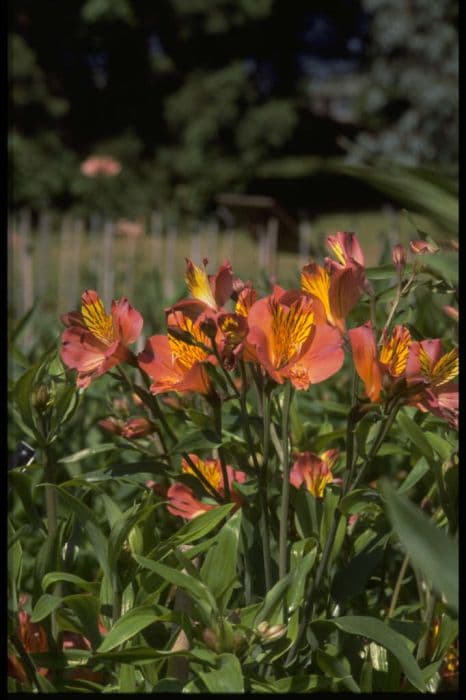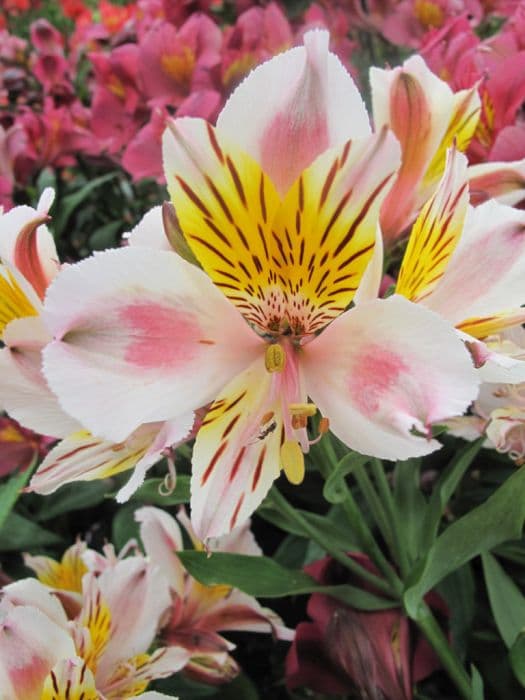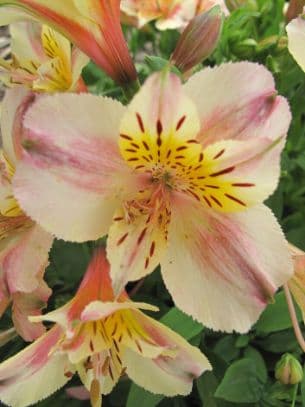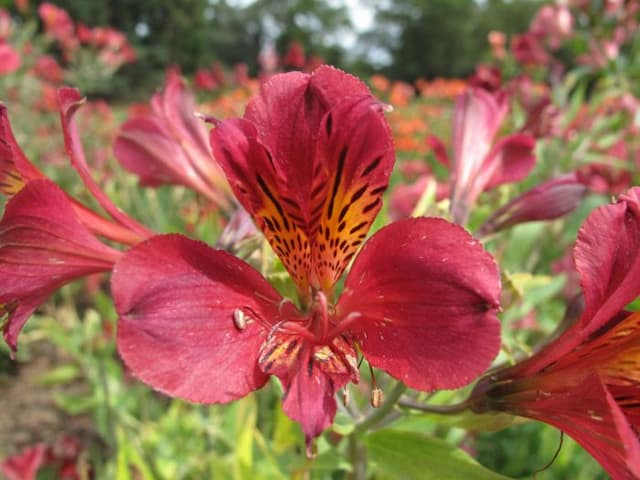Peruvian Lily Alstroemeria 'Celine'

ABOUT
The Alstroemeria 'Celine', also known as the Peruvian Lily or Lily of the Incas, features a striking and vibrant appearance. The blooms of 'Celine' are characterized by their unique beauty, showcasing a blend of colors that typically feature a mix of pink and creamy yellow hues. Each flower is trumpet-shaped with six distinct petals, often flecked or streaked with dark speckles, adding to their charm and detail. The petals themselves have a slight curve, giving the blossoms a luscious and full appearance. The foliage of 'Celine' is fresh green, comprising lance-shaped leaves that twist and turn, making the leaves appear upside down. These leaves give a lush backdrop to the flamboyant flowers. The plant exhibits an upright form with multiple stems that bear clusters of the showy flowers. Overall, this Alstroemeria cultivar exudes a sense of elegance and exoticness, making it a popular choice for garden display and floral arrangements.
About this plant
 Names
NamesFamily
Alstroemeriaceae
Synonyms
Peruvian Lily, Lily of the Incas, Parrot Lily
Common names
Alstroemeria 'Celine'
 Toxicity
ToxicityTo humans
The Peruvian lily, including the Alstroemeria 'Celine' variety, may cause mild toxicity when ingested by humans. It contains tulipalin A and tulipalin B, which can lead to gastrointestinal upset if someone eats parts of the plant. Symptoms might include nausea, vomiting, and diarrhea. Handling the plant without protection might also cause skin irritation or dermatitis in sensitive individuals due to its content of calcium oxalate crystals.
To pets
The Peruvian lily is also considered mildly toxic to pets, including cats and dogs. Ingestion may lead to similar symptoms as seen in humans, such as vomiting, diarrhea, and possible gastrointestinal irritation. If a pet consumes a significant quantity of the Peruvian lily, it is advisable to contact a veterinarian to ensure the animal receives appropriate care and to prevent more serious complications. However, severe toxicity is rare.
 Characteristics
CharacteristicsLife cycle
Perennials
Foliage type
Deciduous
Color of leaves
Green
Flower color
Mixed
Height
2-3 feet (60-90 cm)
Spread
1-2 feet (30-60 cm)
Plant type
Herb
Hardiness zones
7
Native area
South America
Benefits
 General Benefits
General Benefits- Long-lasting blooms: Alstroemeria, commonly known as Peruvian Lily, is renowned for its prolonged flowering season, providing color in the garden for many months.
- Attracts pollinators: The flowers of the Peruvian Lily attract bees and butterflies, which helps to pollinate other plants in the garden.
- Vibrant colors: Alstroemeria 'Celine' offers a range of vibrant colors that bring a bright and cheerful aesthetic to your garden or floral arrangements.
- Excellent cut flowers: The long, sturdy stems and longevity of the blooms make them ideal for use in cut flower arrangements.
- Drought tolerance: Once established, Peruvian Lilies have good drought tolerance, making them suitable for gardens with less frequent watering.
- Easy to grow: They are relatively easy to care for, requiring minimal maintenance, which is ideal for busy gardeners or those new to gardening.
- Versatility: Suitable for borders, containers, and as ground cover, Alstroemeria 'Celine' is a versatile plant that can fit into various garden designs and spaces.
 Medical Properties
Medical PropertiesThis plant is not used for medical purposes.
 Air-purifying Qualities
Air-purifying QualitiesThis plant is not specifically known for air purifying qualities.
 Other Uses
Other Uses- Crafting natural dyes - The petals of the Alstroemeria, also known as Peruvian Lily, can be used to extract natural dyes for coloring fabrics, yarns, or paper.
- Edible decoration - While not widely known for its edibility, the petals of Peruvian Lily can be crystallized or used fresh as an ornate, albeit unusual, garnish on desserts and high-end culinary dishes.
- Photography subject - The intricate patterns and vivid colors of the Peruvian Lily make it a captivating subject for macro and nature photographers.
- Art inspiration - The unique beauty of the Peruvian Lily often inspires artists and can be used as a model for drawings, paintings, and other forms of art.
- Teaching botany - Due to its interesting genetic traits, such as complex flower structures and hybrid vigor, Peruvian Lilies can be used as educational specimens in botany classes.
- Eco-friendly confetti - Dried Peruvian Lily petals can serve as biodegradable confetti for outdoor celebrations, reducing environmental impact.
- Mood-setting in hospitality - Peruvian Lilies can be used in hotel lobbies or room decorations to create a welcoming and luxurious atmosphere for guests.
- Floating decorations - The sturdy petals of the Peruvian Lily can float, making them suitable for use in water features or as floating centerpieces in bowls.
- Theme gardens - Peruvian Lilies can be planted to create themed garden spaces, such as a South American or exotic-themed garden area.
- Book pressing - The colorful petals of the Peruvian Lily are ideal for pressing in books to create artistic bookmarks or to adorn handmade cards and scrapbooks.
Interesting Facts
 Feng Shui
Feng ShuiThe Peruvian lily is not used in Feng Shui practice.
 Zodiac Sign Compitability
Zodiac Sign CompitabilityThe Peruvian lily is not used in astrology practice.
 Plant Symbolism
Plant Symbolism- Friendship and Devotion: Alstroemerias, also known as Peruvian Lilies or Lily of the Incas, often symbolize strong bonds of friendship and unwavering devotion due to their intertwined growth patterns and supportive stems.
- Wealth, Prosperity, and Fortune: The Peruvian Lily is sometimes associated with wealth and prosperity, making it a popular choice for celebratory occasions and gestures of encouragement.
- Mutual Support: With its interlaced leaves which represent the interwoven nature of relationships, the Peruvian Lily symbolizes the support friends and loved ones offer each other.
- Strength and Resilience: Known for its ability to adapt to various climates and conditions, the Peruvian Lily represents strength, resilience, and the ability to withstand challenges.
- Achievement of Personal Aspirations: Due to their lush and vibrant appearance, these flowers are often seen as symbols for reaching one's personal goals and aspirations.
- Longevity: The perennial nature of the Peruvian Lily, which allows it to bloom for a long period, stands for long-lasting relationships and life endurance.
 Water
WaterPeruvian lilies, like Alstroemeria 'Celine', should be watered regularly to maintain evenly moist soil, especially during their growing season in spring and summer. An established plant typically requires watering once every week with about 1 gallon of water per plant, depending on the climate and soil type. During periods of high heat or drought, you may need to water twice a week. It's important to water directly at the base of the plant to avoid wetting the foliage, which can lead to fungal diseases. In the winter, you can reduce watering as the plant's growth slows down.
 Light
LightPeruvian lilies thrive in bright, indirect light when grown indoors and require full sun to partial shade when grown outdoors. The best spot for Alstroemeria 'Celine' would be a location where it receives morning sunlight and some afternoon shade to protect it from the intense heat of the day. Ensure the plant is protected from intense midday sun to prevent scorching of the leaves.
 Temperature
TemperatureThe ideal temperature range for growing Peruvian lilies is between 65°F and 80°F. Alstroemeria 'Celine' can survive minimum temperatures of around 50°F, but should not be exposed to temperatures below freezing. It’s important to protect the plant from frost and prolonged exposure to temperatures over 90°F which can stress the plant.
 Pruning
PruningPruning Peruvian lilies helps to encourage bushier growth and more blooms. For Alstroemeria 'Celine', deadhead spent flowers to promote continued blooming. Cut back the stem to the base after flowering to clean up the plant and encourage new growth. Pruning is best done in the fall after the plant has finished blooming for the season, though deadheading can be done throughout the blooming period.
 Cleaning
CleaningAs needed
 Soil
SoilThe best soil mix for Peruvian Lily should be fertile, well-draining with a mixture of loam, peat, and sand. The ideal soil pH for Peruvian Lily ranges from 5.5 to 7.0 for optimal growth.
 Repotting
RepottingPeruvian Lilies should be repotted every 2 to 3 years to refresh the soil and to accommodate the expanding root system.
 Humidity & Misting
Humidity & MistingPeruvian Lily thrives in moderate humidity levels, ideally between 40% to 60% to support healthy growth.
 Suitable locations
Suitable locationsIndoor
Place Peruvian Lily in bright, indirect light with proper soil mix.
Outdoor
Grow in partial shade, shelter from wind, well-drained soil.
Hardiness zone
8-10 USDA
 Life cycle
Life cycleThe Alstroemeria 'Celine', commonly known as Peruvian lily or lily of the Incas, begins its life as a dormant rhizome (root structure) that, when planted in early spring, will germinate as soil temperatures warm. The plant then sends up shoots that develop into lush, foliage-covered stems, during which time it establishes a strong root system. As the plant matures, buds form that blossom into the characteristic vibrant, trumpet-shaped flowers, usually in late spring to early summer. After the flowering period, the plant enters a phase of seed production if pollinated, although many gardeners deadhead the flowers to encourage further blooming and to maintain plant vigor. During the fall or in response to shorter day lengths and cooler temperatures, the Alstroemeria 'Celine' may die back, with its above-ground parts withering, while the rhizomes overwinter in the soil. With the return of warmer weather in the following spring, the cycle begins anew with the emergence of fresh growth from the surviving rhizomes.
 Propogation
PropogationPropogation time
Spring-Early Summer
The Alstroemeria 'Celine', commonly known as the Peruvian lily or lily of the Incas, can be propagated most effectively through division, which is best done in the early spring. This method involves gently separating the rhizomes, which are the underground stems from which the roots grow. Gardeners should dig up the clump of rhizomes with care, making sure to minimize damage to the roots. Once the clump is excavated, it can be broken into sections, each with at least one bud or shoot. These sections are then replanted at the same depth they were growing before, spaced about 12 to 18 inches (approximately 30 to 45 centimeters) apart to provide enough space for future growth. Providing a well-draining soil and consistent moisture will help ensure successful establishment of the new plants.



![Peruvian lily [Princess Carmina]](/_next/image?url=https%3A%2F%2Fplants-admin.emdemapps.com%2Fimages%2Fplants%2F%2Fimages%2F604b5b436505f.png&w=640&q=75)


![Peruvian lily [Inca Glow]](/_next/image?url=https%3A%2F%2Fplants-admin.emdemapps.com%2Fimages%2Fplants%2F%2Fimages%2F604b5e99e48d9.png&w=640&q=75)
![Peruvian lily [Inca Smile]](/_next/image?url=https%3A%2F%2Fplants-admin.emdemapps.com%2Fimages%2Fplants%2F%2Fimages%2F604b5cad8fa91.png&w=640&q=75)
![Peruvian lily [Inticancha Passion]](/_next/image?url=https%3A%2F%2Fplants-admin.emdemapps.com%2Fimages%2Fplants%2F%2Fimages%2F604b5f7a78c8d.png&w=640&q=75)
